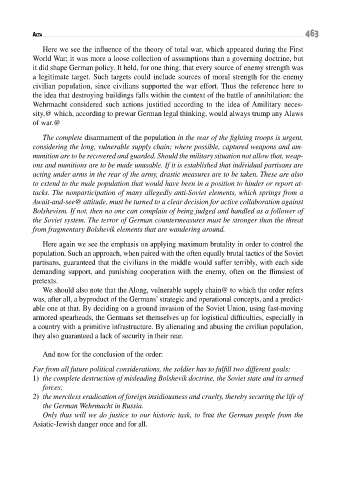Page 463 - Conflitti Militari e Popolazioni Civili - Tomo I
P. 463
463
aCta
Here we see the influence of the theory of total war, which appeared during the First
World War; it was more a loose collection of assumptions than a governing doctrine, but
it did shape German policy. It held, for one thing, that every source of enemy strength was
a legitimate target. Such targets could include sources of moral strength for the enemy
civilian population, since civilians supported the war effort. Thus the reference here to
the idea that destroying buildings falls within the context of the battle of annihilation: the
Wehrmacht considered such actions justified according to the idea of Amilitary neces-
sity,@ which, according to prewar German legal thinking, would always trump any Alaws
of war.@
The complete disarmament of the population in the rear of the fighting troops is urgent,
considering the long, vulnerable supply chain; where possible, captured weapons and am-
munition are to be recovered and guarded. Should the military situation not allow that, weap-
ons and munitions are to be made unusable. If it is established that individual partisans are
acting under arms in the rear of the army, drastic measures are to be taken. These are also
to extend to the male population that would have been in a position to hinder or report at-
tacks. The nonparticipation of many allegedly anti-Soviet elements, which springs from a
Await-and-see@ attitude, must be turned to a clear decision for active collaboration against
Bolshevism. If not, then no one can complain of being judged and handled as a follower of
the Soviet system. The terror of German countermeasures must be stronger than the threat
from fragmentary Bolshevik elements that are wandering around.
Here again we see the emphasis on applying maximum brutality in order to control the
population. Such an approach, when paired with the often equally brutal tactics of the Soviet
partisans, guaranteed that the civilians in the middle would suffer terribly, with each side
demanding support, and punishing cooperation with the enemy, often on the flimsiest of
pretexts.
We should also note that the Along, vulnerable supply chain@ to which the order refers
was, after all, a byproduct of the Germans’ strategic and operational concepts, and a predict-
able one at that. By deciding on a ground invasion of the Soviet Union, using fast-moving
armored spearheads, the Germans set themselves up for logistical difficulties, especially in
a country with a primitive infrastructure. By alienating and abusing the civilian population,
they also guaranteed a lack of security in their rear.
And now for the conclusion of the order:
Far from all future political considerations, the soldier has to fulfill two different goals:
1) the complete destruction of misleading Bolshevik doctrine, the Soviet state and its armed
forces;
2) the merciless eradication of foreign insidiousness and cruelty, thereby securing the life of
the German Wehrmacht in Russia.
Only thus will we do justice to our historic task, to free the German people from the
Asiatic-Jewish danger once and for all.

